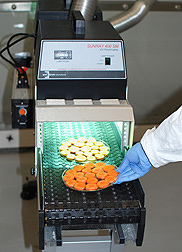This page has been archived and is being provided for reference purposes only. The page is no longer being updated, and therefore, links on the page may be invalid.
| Read the magazine story to find out more. |
|
|
Ultraviolet Light Boosts Carrots' Antioxidant Value
By Marcia WoodJanuary 5, 2011
Exposing sliced carrots to UV-B, one of the three kinds of ultraviolet light in sunshine, can boost the antioxidant activity of the colorful veggie. That's according to preliminary studies by U.S. Department of Agriculture (USDA) research food technologist and research leader Tara H. McHugh. She is with the Agricultural Research Service (ARS), USDA's chief intramural scientific research agency.
Found primarily in fruits and vegetables, antioxidants are natural compounds that may reduce risk of cancer and cardiovascular disease.
The carrot investigation, conducted by McHugh, postdoctoral associate Wen-Xian Du, and others at the ARS Western Regional Research Center in Albany, Calif., suggests that a moderate, 14-second dose of UV-B can boost fresh, sliced carrots' antioxidant capacity by about 3-fold. The dose is energy-efficient and does not significantly heat or dry the carrots.
Scientists have known for at least a decade that exposing plants to UV-B may cause what's known as abiotic stress. That's what probably happened with the sliced carrots.
Plants respond to the stress by revving up their production of two natural enzymes, one with the tongue-twisting name of polyphenylalanine ammonia-lyase, and the other known as chalcone synthase. As production of those enzymes increases, levels of phenolic compounds—antioxidants synthesized by the enzymes—also increase.
Despite this and other knowledge about plants' responses to stress and to UV-B, the idea of using UV-B to quickly, safely, and conveniently enrich the antioxidant heft of fresh produce has not been extensively studied, McHugh notes. The carrot research is helping fill in that knowledge gap.
Read more about the research in the January 2011 issue of Agricultural Research magazine.

